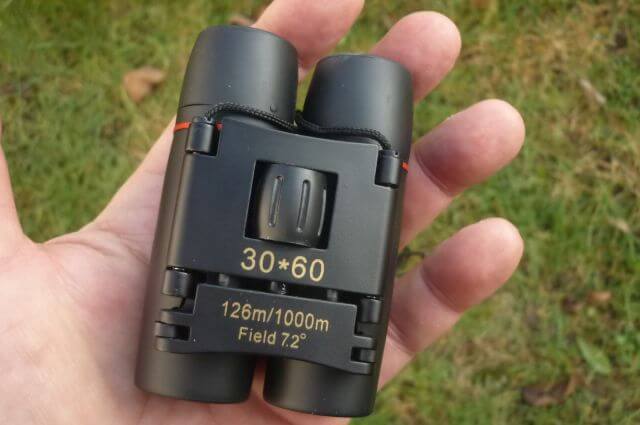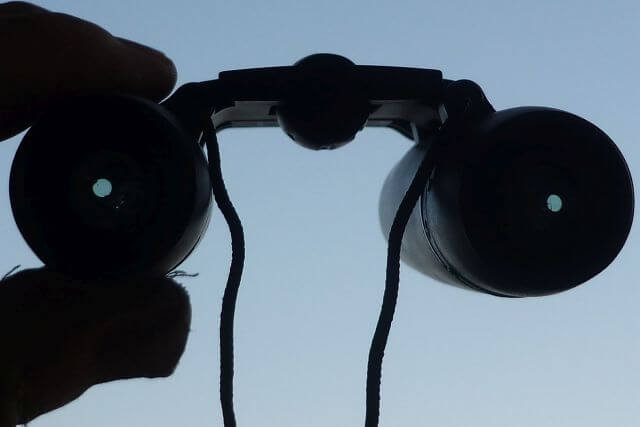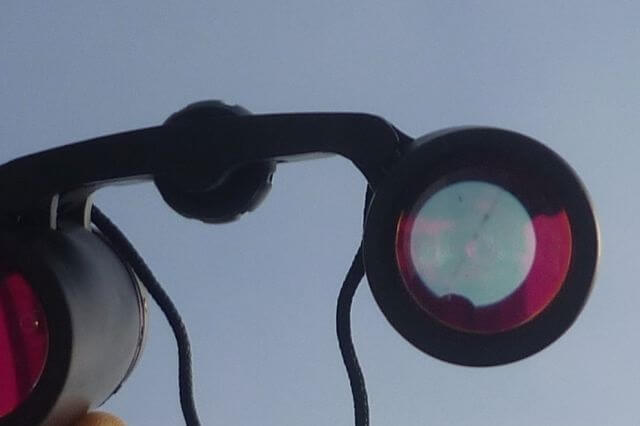This post contains affiliate links. If you click on a link and make a purchase I earn a small commission at no extra cost for you.
I just had to buy these tiny “30×60 Compact Folding Binoculars” because I wanted to know what die 30×60 means and whether that thing was any good at all. After all, this is a bestseller on Amazon. It is sold from various sellers under different labels, sometimes with quite different specifications. But it seems to be made by the same factory in china.
If you look around you can find it for as low as around 10 $, which is unbelievable. That’s what cheap sunglasses cost with two thin plastic lenses. How can an optical instrument with 3 or 4 lenses and a prism be so cheap? Low price seems to be a buying incentive to many people who don’t know about binoculars. But can you get reliability, functionality, and at least some optical performance from such cheap binoculars, or are they just a bad toy?

What does 30×60 binoculars mean?
That’s a really good question, I was also wondering what 30×60 binoculars actually means. And it gets even more confusing when you read the specs of these tiny binoculars. Usually, the numbers that are prominently advertised on binoculars are about the magnification and aperture of the collecting lens.
The first number stands for the magnification, i.e. how many times larger an observed object appears. The second number stands for the diameter in mm of the objective lens, the front large lens facing the object. You can see at first glance that the front lens of this 30×60 binoculars model does not have 60mm (= 2.36 inches) diameter.
So the “30×60” must be a marketing gimmick, to stand out from the crowd of other cheap compact binoculars. Probably the same with the claim of Day and Night Vision. Go figure.
The binoculars I am holding here are 8×21, with 8x magnification, and a 21mm objective lens, even if it is not so stated on it.
I can simply measure the objective lens. And the magnification, I can derive from the degree of the field of view. The field of view is given as 7.2 degrees, by simply multiplying by 17.45 the corresponding “meter value” can be calculated. I get about 126 meters as advertised on the instrument. A field of view of 126/1000 m corresponds to about 8x magnification.
Specs of the 30×60 Binoculars
| Optical Glass | Standart Crown |
| Lens Coating | Fully coated |
| Prism systems | BK7 |
| Magnification | 8x |
| Objective diameter | 21 mm |
| Exit pupil | 2.6 mm |
| Eye relief | 5 mm( est) |
| Field of view | 126/1000m 378/1000yrd |
| Close focus | 15 feet 5 meter |
| Twilight factor | 12.96 |
| Water resistance | Water-resistant – IPX6 |
| Weight | 5.1 oz/ 147 gr |
First general impression

When you take the thing out of the box and hold it in your hand then the first impression is actually not that bad. It looks pretty good and feels quite sturdy when you hold it in your hand. Folding the barrels apart is smooth, nothing wobbles, shakes, or loose, the hinges are decent too. The center focus wheel is quite small, but it rotates gently and evenly.
For the compact size, it feels heavier than expected, but that’s because the barrels and middle bridge are made of aluminum, one would actually have expected plastics. Amazing for so little dollars, you wonder how they do it. But how good are the optics and the performance?

Mechanics
As I just said, the housing feels sturdy, nothing wobbles. It is made of aluminum, the hinges also work perfectly, the barrels can be easily folded out to adjust to the eye distance. The Center Focus wheel turns smoothly, there is nothing to complain about the mechanics. The right eyepiece has a diopter correction, there is only + / -, no values are given.
The optics
Binoculars 8 × 21 are compact and easy to use. They don’t weigh much and they fit in every pocket. 8×21 binoculars are suitable for use in daylight, for occasional viewing of distant objects, happenings, or events.
When buying such small compact binoculars, however, you should pay attention to good workmanship and reasonably good optics. The lenses, especially the objective lens, should have good coatings to provide sufficient light transmission so viewed images appear bright enough.
Night Vision?
8×21 is good during the day, but for use at night, not really unless what is to be observed is sufficiently brightly lit. Night vision usually refers to residual light amplification, this model definitely doesn’t have that.
In order for binoculars to be suitable for low light, it needs a large objective lens so that a lot of light can be collected. A large lens ensures a high twilight factor and a high relative brightness.
The Twilight factor of an 8×21 is only 12.96 and the Relative brightness is only 6.8. For binoculars to be really suitable for night use, both values should be around 15 or more.
Also, the exit pupil of an 8×21 binocular is only a little more than 2mm in size, very little for night use.
As you know, in darkness the pupil of the human eye opens to over 5 mm to let in a lot of light. So for binoculars to be suitable for night use, they must have a large exit pupil.
Ruby Red Lens Coating

As I just said, good coatings have a major influence on the brightness of the observed image because they increase transmission.
The ruby-red coating on the objective lens looks great. Actually, it is intended to increase the contrast of the viewed image in bright sunlight, since the red components of the light are largely filtered out. But this only works in really high-quality optical glasses. In addition, it also leads to a colder, more blue-tinged image because the warm red components of the spectrum are filtered out.
Filtering out the red has the advantage in poor-quality optics that it helps reduce color aberrations, simply because red is missing. The binoculars also lose their low light suitability due to the strong reflecting effect of the red coating. It looks good, but nothing else.
Prisms

If you hold the bino outstretched arm in front of a light background and look at the exit pupil, it appears uniformly round. A good sign, as this speaks for the use of BaK4 glass prisms. Amazing at the low price.
 A straight line does attract attention. It is even better to see when turning it around and looking into the lens from the front. Amazingly, you can’t see anything of the line when use the binos normally. This can actually only be caused by the roof prism where the two glass blocks seem not to lie flush on each other, there must be a tiny gap.
A straight line does attract attention. It is even better to see when turning it around and looking into the lens from the front. Amazingly, you can’t see anything of the line when use the binos normally. This can actually only be caused by the roof prism where the two glass blocks seem not to lie flush on each other, there must be a tiny gap.
Eye Relief
This is the distance between the eyepiece and the place where the viewed image appears to be. This is important for people who wear glasses, as the glasses prevent the binoculars from being held so close to the eye. If the eye relief is too short, you will only be able to see an incomplete image with shadows at the edge. The instrument here with its 5mm eye relief is unsuitable for someone who always has to wear glasses.
If you always have to use glasses, make sure you have sufficient eye relief when buying them, only then that binoculars are suitable for people who wear glasses. Trying out which model offers the best viewing comfort is very important.
Collimation
The two binocular tubes in my model here, are not perfectly aligned to each other. This is hardly noticeable under normal observation. The difference is small so that the brain can overlay the images. However, if I blink my eyes alternately, I can clearly see that a targeted post does not appear in the same place, but is slightly offset.
Binocular at the lower end of the budget binoculars, only run through random quality control, not every model is checked for functionality and flawless assembly.
Since there are always tolerances in the manufacture of the parts and when assembling them, it is imperative that you check for correct collimation. If you notice double vision then you should request a replacement.
Edge Blurring
Edge blurring and a distortion towards the edge of the picture are of course to be expected. The images are only focused in the middle and about halfway through the field of view, the blurring begins, which increases considerably towards the edge.
Chromatic Aberration / Color Fringing
When you look at branches against the bright sky or a power pole against a light background, you can see the chromatic aberration quite clearly. Red is not so prominent because of the red coating, but you can see blue and greenish brownish fringes at the light and dark transitions.
Color fidelity
As already mentioned above, the ruby-red lens coating filters out the red part of the light. This creates a shift towards the bluish, which can be clearly seen that the images have a blue haze.
Pros
- Sturdy housing and smooth mechanics
- Very small and compact
- Diopter compensation
- Carry case, a string for a neck strap, and a cleaning cloth.
- Super cheap
Cons
- Poor optics
- Edge blur
- Color fringing
Conclusion
In summary, you can’t expect much for the low price. But if you take a closer look and consider the low price, then you have to acknowledge that they have done well. Hard to believe.
The aluminum housing is sturdy, with a non-slip rubber coating that also protects the instrument a bit. The mechanical parts, the focus wheel, and the diopter compensation function smoothly and evenly.
The fact that the optics leave much to be desired, that the image is only focused in the middle of the field of view, edge blurring, and chromatic aberrations can be seen so clearly, is due to the low price.
The observed images are not the brightest, with a 21mm aperture and the glass used, that’s the way it is. It is enough for daytime use, you can forget about night vision and use in the dark.
Would I buy it again?
Nope! Mainly because of the poor viewing comfort. So you really have to hold the bino exactly in front of your eyes to try to hit its exit pupil and eye relief, otherwise, there will be annoying shadows and restrictions in the field of view. The blurred edges and the color fringing are also too much. For just a few dollars more you can get a compact Bresser Topas or a small Bushnell Powerview, with which you have more fun viewing.
Who are these cheap binoculars for?
For occasional use, if something is too far away to be seen with the naked eye, then these binoculars definitely serve their purpose. But for more demanding use, be it nature, wildlife, or bird watching, there are better binoculars that you can buy for a little more money.
These seem to be made by several manufacturers under different brands. You’ll find even more…







